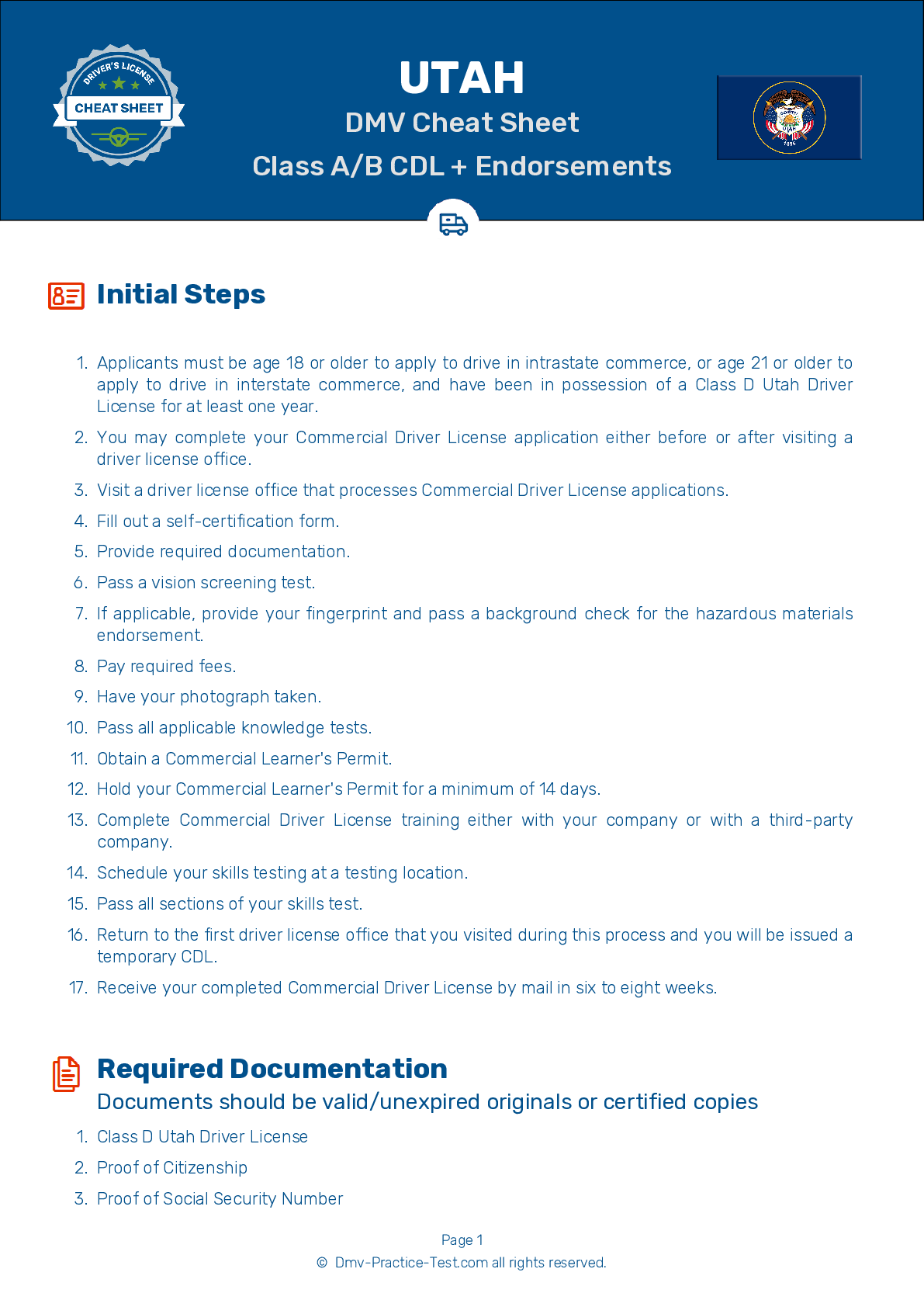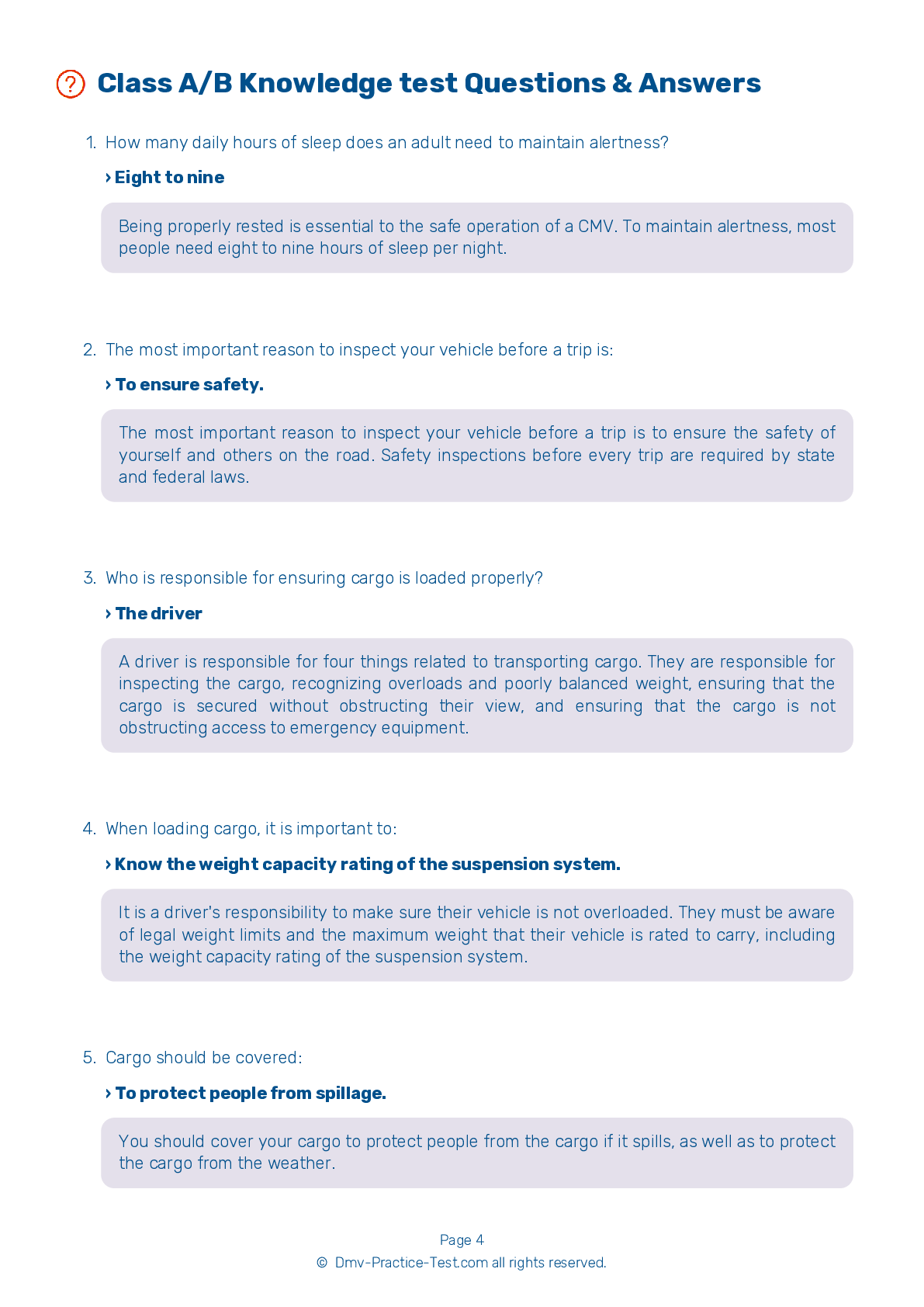Air Brakes #2
Air Brakes Endorsement Test | Utah 2025 #2 Page 2 of 4
Train for FREE online with our Utah CDL air brake test. The official exam test consists of several obligatory parts, with all of them checking your knowledge of different blocks of road rules. If you need to obtain a UT Class A/Class B driver license in 2025, practice as much as possible. Free sample tests published on our website will help you check and improve your knowledge and boost your grades. Please bear in mind that the requirements for CDL may vary from state to state.
25
20
20
7 . Some air brake systems use alcohol:
To reduce the risk of rust forming on air brake valves.
Some air brake systems contain an alcohol evaporator. This device introduces alcohol into the braking system to inhibit the formation of ice.
8 . What happens if the air pressure in a system's air tanks falls below 60 psi?
The vehicle should stop.
In an air brake system, a low pressure warning signal should activate if the pressure in the air tanks falls to a level below 60 psi. This signal may be in the form of a warning light or a wig wag.
9 . If using air tanks with manually operated drains, how often should you drain the tanks?
Once every 3,000 miles
To prevent the build up of oil and water in a vehicle's air tanks, manually operated air tank drains should be used at the end of each day of driving.
10 . Truck tractors with air brakes that were built on or after March 1, 1997 are equipped with:
Anti-Lock Braking Systems (ABS).
Truck tractors with air brakes that were manufactured on or after March 1, 1997 are required to be equipped with Anti-Lock Braking Systems (ABS). ABS is required in any other type of vehicle with air brakes that was manufactured on or after March 1, 1998.
11 . Before driving a vehicle with air brakes, you should ensure that the spring brakes come on automatically when:
Driving uphill.
Before driving a vehicle with air brakes, you should ensure that the spring brakes come on automatically when air tank pressure falls to a level between 20 and 45 psi. You can do this by chocking the wheels and releasing air from the braking system by stepping on and off the brake pedal. Once the pressure drops to an unsafe level, the parking brake valve should pop out and spring brakes should come on.
12 . ABS brakes:
The purpose of an Anti-Lock Braking System (ABS) is to prevent a vehicle's wheels from locking up when the driver brakes hard on a slippery surface.
2025 Utah | Frequently Asked Questions
To secure a CDL Bus endorsement in Utah, you must first have a Commercial Driver's License (CDL). Then, pass the Passenger Vehicle written test. After passing the test, you have to complete a training course and pass a skills test in the type of vehicle you will be driving. Lastly, pay the required fees.
To obtain a CDL Bus license in Utah, you need a valid driver's license, be at least 21 years old, and pass a vision test. You must also complete a CDL application and pass the General Knowledge test, Passenger Transport test, and School Bus Endorsement test if applicable. Lastly, you must pass a pre-trip vehicle inspection and a skills test.
Yes, specific training is necessary for a CDL Bus endorsement in Utah. After passing the Passenger Vehicle written test, you must complete a training course that includes both classroom and hands-on driving instruction. This training is designed to provide you with the skills needed to safely operate a bus and handle passengers.
CDL Bus licenses in Utah fall under three classifications: Class A, B, and C. Class A is for vehicles with a combined weight over 26,001 lbs where the towed vehicle exceeds 10,000 lbs. Class B is for single or combination vehicles where the single vehicle exceeds 26,001 lbs. Class C is for vehicles designed to transport 16 or more passengers, including the driver.
No, you cannot use your personal vehicle for the CDL Bus driving test. The vehicle you use must match the class of CDL you're applying for. So, for a bus endorsement, you'll need to test in a commercial bus. This ensures you can handle the specific vehicle type in real-world scenarios.
During the CDL Bus driving test in Utah, you will be evaluated on various skills including pre-trip vehicle inspection, basic vehicle control, and on-road driving. This includes maneuvers like stopping at designated points, backing up in a straight line or into a docking area, turning, merging and exiting traffic, and navigating intersections or railway crossings.
Yes, to obtain a CDL Bus endorsement in Utah, you must pass a Department of Transportation (DOT) physical examination. This exam ensures you're physically capable of safely operating a commercial vehicle. It covers aspects like vision, hearing, blood pressure, and checks for conditions like diabetes or heart disease that could interfere with driving safety.
No, it is illegal to transport passengers in a commercial vehicle without a valid CDL Bus endorsement in Utah. Driving a commercial vehicle, such as a bus, without the appropriate license can result in hefty fines, license suspension, or even jail time. Always ensure you have the correct endorsements for the vehicle you're operating.
Yes, the CDL Bus endorsement can be added to your existing CDL license in Utah. You'll need to pass the passenger endorsement knowledge test and a skills test in the vehicle group you wish to drive. However, you won't need to apply for a new CDL license altogether.
Yes, there are restrictions for drivers with a CDL Bus endorsement in Utah. Drivers must not have any serious traffic violations within the past two years. They are also subject to random drug and alcohol testing. Moreover, they must comply with federal regulations regarding hours of service, which limit the number of hours they can drive without rest.



